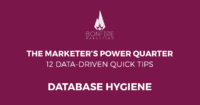Google Analytics’ Data Import functionality is one of the more useful but underused features in the platform. Google Analytics captures a lot of data automatically, but providing the option to import all kinds of custom data makes its power infinite.
If you’re conducting campaigns on paid marketing channels other than AdWords, the cost data import feature is highly useful for ROI analysis and cross-channel comparisons. In just nine easy steps, you can import cost, clicks, and impressions from Bing Ads, Facebook, Twitter, AdRoll, Yahoo, and more. For this exercise, we will focus on how to import Bing Ads data into Analytics to directly compare performance with AdWords.
Step 1: Create custom campaign URLs using UTM codes
Be sure to append all your URLs from your paid channels with custom campaign URLs to ensure your traffic is properly recorded inside Google Analytics. Use Google’s URL builder to quickly and simply tag your URLs with your desired campaign sources and mediums.

For Bing ads, tag your URLs with “bing” and “cpc.” Your Bing ad traffic will then record as follows:

Step 2: Create a custom data set using Data Import
To begin the data import process, click on the Admin panel in Google Analytics and select Data Import under the property settings.

Step 3: Select your imported data set
Inside the Data Import dashboard, select +New Data Set.

Analytics offers a variety of data import options, including demographic and user data, as well as options to customize data specific to industries and niches. But this post will focus solely on cost data.
To import cost data, select Cost Data under Summary Data Import.

Step 4: Name the data set and check each Analytics view using the data set
Name your data set whatever makes the most sense. Typically, you should segment your data sets by channel, so Bing, Facebook, Twitter, and AdRoll all have their own sets you can routinely update with new data.

Then select Enabled Views. If you want your cost data to appear in all your views, select every view available in your account.
Step 5: Choose the correct data schema and export a CSV file
To import all necessary paid ads data, select all the provided dimensions and metrics, including clicks, cost, and impressions at the campaign, ad group, and keyword levels.

Then select Summation as the Import Behavior, and click Save. Summation is the default setting, and means any new data will be added to previous matching data and the metrics will be summed together. Use this option, as the other option will overwrite previous data.
Then select Download Schema Template.

Analytics will then export a CSV with the following headers:

This will be the template used to import your cost data.
Step 6: Export cost data from your preferred platform
Since this exercise uses Bing as an example, we will use the Bing platform to gather our data.
Enter the Bing ad platform, click on the Reports tab, and choose Keyword from the Report Type dropdown. Under general settings, select Day as the unit of time, and choose your desired date range. If it’s your first time importing your Bing cost data, you may run a report for the entire history of your campaigns if you desire.

Then select the desired columns you’d like to export. Be sure to include campaign, ad group, keywords, impressions, clicks, and spend. Bing will then develop a CSV that looks something like this:

Step 7: Format CSV template file, input data, and upload to Analytics
Your next step will be to format your exported Bing data into the CSV document provided by Analytics.
Take the data from your Bing export, and drop it into the correlating categories in the Analytics export.
Be sure to change the date format to YYYY-MM-DD from the standard Gregorian format. This step is critical to your data properly importing into Analytics.
Your final CSV should look something like this:

Step 8: Import cost data into Google Analytics
Go back to Data Import under the Admin panel in Google Analytics. (Note: Data can take up to 24 hours to actually appear in the Google Analytics interface.) Then select Manage Uploads under your preferred data set.

Click Upload File and select your cost data CSV. If your CSV is properly formatted and uploads property, the file’s status will read completed.

Your Bing cost data will then import into Google Analytics. This process may take up to 24 hours, but typically only takes a few minutes.
Now it’s time to take a look at your new data.
Step 9: Reporting: Cost Analysis report and Model Comparison Tool
You can analyze and compare your cost data under two powerful reports: the Cost Analysis report and the Model Comparison Tool.

Cost Analysis
Under the Campaigns tab in Acquisitions, the Cost Analysis tool provides thorough, flexible data on cost, CPC, and ROI for all your paid marketing channels. The more data you import from your different paid channels, the more you can compare how effectively and efficiently each channel performs.

Model Comparison Tool
The Model Comparison Tool is an even more thorough reporting tool. Located under the Goals tab, this tool is a great way to explore how your channels may work in tandem or in support of your other marketing channels, providing data on assisted and non-direct conversions in addition to last interaction credits.
Importing cost data into Google Analytics is a powerful way to analyze and identify the effectiveness of your paid digital channels. With just a few simple uploads, you can view your cost data side by side, parsed, and filtered using Google Analytics’ powerful metrics tools.
More Content
How to Create Personas With Google Analytics
Personas are critical for the success of your marketing efforts, digital or not. Strong personas are a reference for every department in your company or agency — from strategy to
The Marketer’s Power Quarter: Updating Lead Databases
This is the tenth in a 12-part series of quick-fix tips to improve your digital marketing results. Catch up on our last tip, and subscribe to our newsletter to get the
AI in Marketing: How to Get Started in 2018
One of the biggest buzzwords in marketing, and really across many industries, is artificial intelligence. For years, a majority of the public viewed AI as science fiction, but that’s starting




Leave A Comment